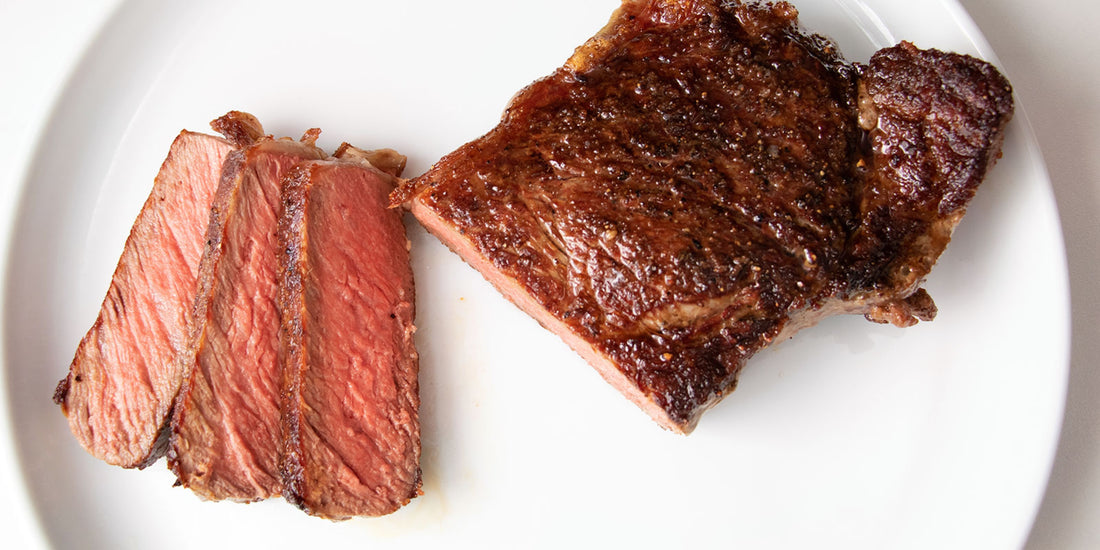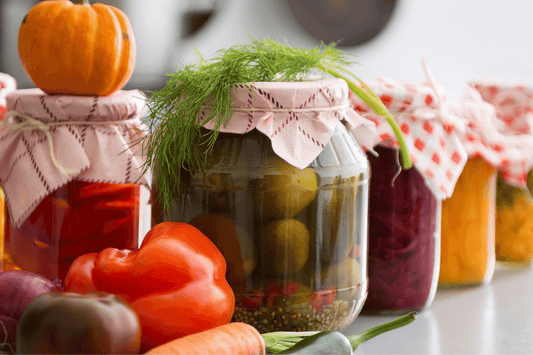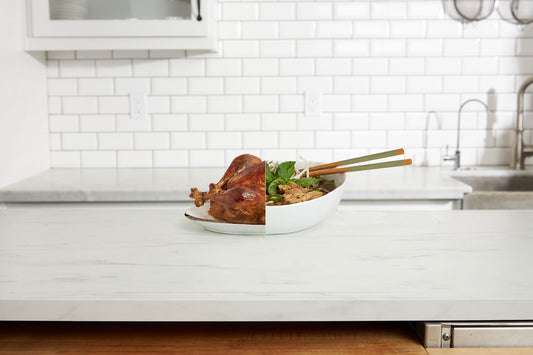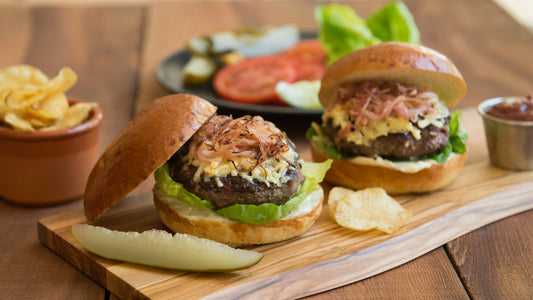By: Julian Weisner (Mad Culinary Scientist), Owen Wyatt (Senior Culinary Development Manager) and Christina Chonody (Culinary & Marketing Mastermind)
Precise Temperature & Timing for Cooking Steak in a Pan
Cooking steak in a pan is the easiest way to turn any weeknight into date night or to treat yourself. That being said, without years of practice or culinary expertise you can easily find yourself in a smoke filled kitchen with an overcooked steak. That is not what we would describe as #winning.
Precise temperature control bridges the gap between home cooking and professional skills; it gives you the tools to perfect a crispy steak crust and a juicy medium rare at the same time. Still, the question around which temperature to use becomes a bit tricky, so we set out to find the answer.
After more than 750 hours cooking steaks and adjusting temperatures, flip methods, and timings, we've zeroed in on the ultimate method to perfectly pan-seared steaks–ideal for your Hestan Cue, but also works for any cooktop.
Get the details on pan-searing steak to perfection below, or get right to the full pan-seared steak chart.

Why Cook Steak in a Pan?
There are many paths to the perfect steak, you could start at the butcher, picking breeds, diets, and dry aging, and then at home try tempering, salt curing, and spicing. All just in time to stoke the coals for grilling, heat the oven for roasting, get a water bath to sous vide or otherwise coax your meat to perfection.
When it comes to making steak on a weeknight and guaranteeing results (without setting off the smoke alarm), a pan on the stove is the way to get it there. And with just a few tips on timing and temperature control, you can achieve that crispy, golden sear sear and a slam dunk medium-rare!
Perfecting Your Pan-Searing Technique: Sear First, Cook Second
When cooking a steak in a pan you need to first start the meat at a high temperature and then finish cooking at a lower temperature. In other words, sear first! By searing first we are able to remove any excess moisture from the meat as fast as possible and jump right into building color and texture.
Cooking methods like oven-baking or grilling will require you to first cook the steak to just below the target temperature and then sear to finish. This means you are drying out the steak while you cook it, reducing the amount of time you will need to produce color. You'll be less likely to overheat your steak while searing, but you'll also lack the thick and crispy texture that a pan-seared finish provides.
In a pan, we are building color and even more importantly, texture, throughout our entire cooking process. To do this as efficiently as possible we give our meat a base coat sear, and then fill it in while we bring it to our desired doneness.
Temperature and Timing for Pan Searing and Cooking Steaks
New York & Ribeye Steak Time & Temp Chart
For either of these steaks start by searing all of the edges and sides for 2 minutes each at 425°F (218°C). Then reduce the temperature to 375°F (190°C) and follow the guide for the recommended times based on the thickness and your desired doneness.

Flat Iron Steak Time & Temp Chart
Only sear the top and bottom surfaces of the steak. Sear each surface for 2 minutes at 425°F (218°C), then reduce the temperature to 375°F (190°C) and continue cooking for the recommended times defined by your steak’s thickness and your desired doneness.

Filet Mignon Time & Temp Chart
Sear only the edges at 425°F (218°C) for 1 minute and 30 seconds each, then reduce the temperature to 375°F (190°C) and cook the top and bottom surfaces for the time listed in the guide, defined by your steak’s thickness and your desired doneness.

Converting Precise Temperature to Traditional Stovetop Settings
We've built settings into the Hestan Cue app to calculate the exact times and temperatures for you, with corresponding cookware that monitors and maintains the proper temperature down to the degree.
If you don't have a Cue, you can still use this guide at home on your regular stovetop for reference, simply follow the recommendations below to see how precision temperatures convert to your stovetop's settings for high, medium, and low.

Pro Tips for Cooking Steak in a Pan
-
Ensure the surface of your meat is dry to maximize browning.
-
Use a good amount of oil to evenly coat the bottom surface of the pan.
-
Do not crowd the pan, ensure there is a space between each piece of meat for a better sear.
-
Add aromatics because it is a great way to add a depth of flavor
Step-by-Step Directions for Cooking Steak on the Stovetop
Using the charts above you can determine the proper time (per side) to cook your steak based on its thickness. The first temperature will be used for searing your steak, while the second temperature will be the actual cooking temperature and timing.
For the full step-by-step recipe, check out the Hestan Cue Pan-Seared Steak Recipe.
- Using Control Mode, set your Hestan Cue smart induction burner to 425°F (218°C).
- Add 2 tablespoons of cooking oil to your pan.
- Determine the appropriate time per side for your steak using the Hestan Cue Time & Temp Charts above.
- Pat your steak on both sides with a paper towel to dry thoroughly
- Season with kosher salt and black pepper.
- Place your steak in the pan and set your timer for the recommended searing time accordingly.
- Flip your steak and continue to sear for the same amount of time on the other side or edge.
- Reduce the temperature on your Hestan Cue smart induction burner to 375°F (190°C).
- Set your timer according to the Hestan Cue Time & Temp Charts. Leave your steak in the pan to let it cook, then flip and do the same for the other side.
- Remove from the pan and allow to rest for 5 minutes.
FAQs for Pan-Searing Steaks
Can I use this guide for my own pan and stove top if I don’t have a Cue system?
Yes! You can even use cast iron! We’ve provided approximate conversions for the temperature and timing for your current stove top. We can’t promise the same results without the precise temperature provided by the Hestan Cue System, but you can still follow along. Use the recommendations below to see how precision temperatures convert to the more familiar high, medium or low settings on your stovetop.

Can I use this guide to cook steaks with the bone or out?
Yes! For both cuts, simply follow the guides, but for bone-in cuts, we recommend basting your steak on the last cook step. Focus your basting on the bone side of the meat as well as the thicker sections to achieve a consistent cook through out.
Does it matter if my steak is grass fed or not?
Yes! From our extensive research we have found that grass fed beef cooks at a faster rate than the more common grain fed beef. For this reason, we recommend selecting the cook times corresponding to an ¼” less than your actual measured steak thickness. This in not an exact solution, but it will greatly benefit your outcome.
I cooked my steak sous vide. Can I use the same times and temperatures to sear it when I finish it?
No, after sous vide cooking you don’t need to cook your steak any more than it is. These times and temperatures will only ruin all of your hard work. Check out more from the Cue chefs in our Quick Guide to Searing Sous Vide Proteins
When should I season my steak?
As long as you season the steak before it goes in the pan, and make sure it is dry when it gets there, you’ll be fine.
Do I need to baste the steak?
No, it is not necessary unless you are using a bone-in cut. But in general, basting can seriously help cook all of your meat more evenly, and we highly recommend doing so. Plus, basting with aromatics in the pan is a restaurant style technique that adds flavor and is sure to impress your friends and family.
Can I add aromatics, like thyme, rosemary, or garlic to the pan?
Absolutely, aromatics are a great way to add flavor. We recommend adding aromatics during the last cooking step, baste the aromatic infused oil on top of your steak during this last step to impart as much of the flavor as possible.
Can I cook my steaks straight from the freezer?
No, these times and temperatures are designed for steak either out of the refrigerator or even after it has been tempered.
Can I reheat cooked steak with these times and temperatures?
No, since your steak is already cooked it will not need to spend nearly as much time to come back up to a servable temperature. Do yourself a favor and whip up something fun like fajita quesadillas or steak and eggs with your leftovers!
Does my steak need to rest after it’s done cooking?
Yes, the cue system factors in “rest time”. This means that we calculate how much your steak will continue to cook out of the pan, and account for that. Consider the rest time an additional cook time, and wait at least 5 minutes before slicing your meat.
Does it matter if I temper my steak before I cook it?
Yes, these numbers are built for an average starting temperature of about 45°F (7°C), if you want to cook your steak directly out of the fridge, you should add a little bit more cook time, likewise for steak that you have taken the time to temper, you can decrease the cook time to get an even juicer result.
What if my steaks are different thicknesses?
You can sear them all at the same time, and then set separate timers for each steak.
We love to see what you are cooking on Cue. Look for more inspiration and share your recipes or ask our Chefs for advice in our Facebook community.
For more recipe inspiration check out the Cue app, where you can discover over 500 chef-crafted recipes, all with step-by-step video guidance from prep to plating. Download the Hestan Cue app for iOS and Android and learn more about precision cooking with Cue, and all the things you can do!




